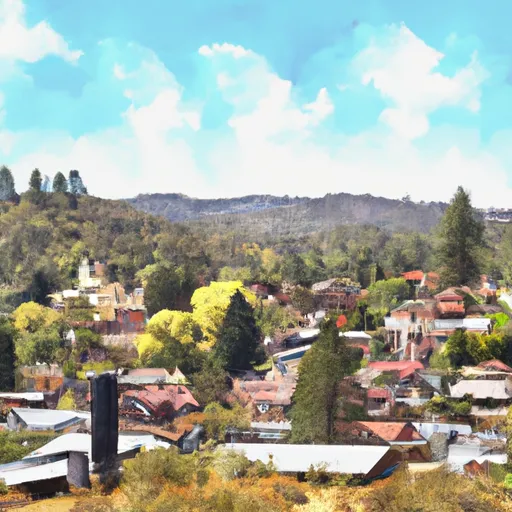-
 Snoflo Premium
Snoflo Premium
Get unlimited access to all our content
With no Ad interruptions! - Start Your Free Trial Login with existing account
Julian
Eden Index
Climate
9.5
•
Recreation
6.0
•
Community
•
Safeguard
5.9/10

Julian, California is a charming mountain town located in San Diego County. It is situated at an elevation of approximately 4,200 feet, which gives it a unique climate compared to the coastal areas of Southern California. The town experiences four distinct seasons, with warm summers and cool winters. Average temperatures range from the 60s°F in summer to the 40s°F in winter, and occasional snowfall is not uncommon.
The hydrology constituents in Julian are primarily influenced by the Cuyamaca Mountains and the nearby Cuyamaca Rancho State Park. The area is known for its pristine natural springs and creeks, which contribute to a rich watershed system. These water sources provide a vibrant ecosystem that supports various species of plants and wildlife.
Outdoor recreation opportunities in Julian abound, attracting nature enthusiasts and adventurers. The Cuyamaca Rancho State Park offers numerous hiking trails, scenic viewpoints, and camping sites. Visitors can explore the diverse flora and fauna while enjoying breathtaking views of mountain peaks and meadows. Additionally, the area is renowned for apple orchards and offers opportunities for apple picking, cider tasting, and enjoying homemade apple pies. Julian provides a perfect retreat for those seeking outdoor activities in a picturesque mountain setting.
What is the Eden Index?
The Snoflo Eden Index serves as a comprehensive rating system for regions, evaluating their desirability through a holistic assessment of climate health, outdoor recreation opportunities, and natural disaster risk, acknowledging the profound impact of these factors on livability and well-being.
Climate Health Indicator (CHI): 9.5
Julian receives approximately
588mm of rain per year,
with humidity levels near 74%
and air temperatures averaging around
15°C.
Julian has a plant hardyness factor of
8, meaning
plants and agriculture in this region tend to thrive here all year round.
By considering the ideal temperature range, reliable water supplies, clean air, and stable seasonal rain or snowpacks, the Climate Health Indicator (CHI) underscores the significance of a healthy climate as the foundation for quality living.
A healthy climate is paramount for ensuring a high quality of life and livability in a region, fostering both physical well-being and environmental harmony. This can be characterized by ideal temperatures, reliable access to water supplies, clean air, and consistent seasonal rain or snowpacks.
Weather Forecast
Streamflow Conditions
Salton Sea
Area Rivers
Salton Sea
Snowpack Depths
Salton Sea
Reservoir Storage Capacity
Salton Sea
Groundwater Levels
Recreational Opportunity Index (ROI): 6.0
The Recreational Opportunity Index (ROI) recognizes the value of outdoor recreational options, such as parks, hiking trails, camping sites, and fishing spots, while acknowledging that climate plays a pivotal role in ensuring the comfort and consistency of these experiences.
Access to outdoor recreational opportunities, encompassing activities such as parks, hiking, camping, and fishing, is crucial for overall well-being, and the climate plays a pivotal role in enabling and enhancing these experiences, ensuring that individuals can engage in nature-based activities comfortably and consistently.
Camping Areas
| Campground | Campsites | Reservations | Toilets | Showers | Elevation |
|---|---|---|---|---|---|
| Bobcat Meadow | 20 | 3,802 ft | |||
| Paso Picacho - Cuyamaca Rancho State Park | 85 | 4,921 ft | |||
| Lake Morena | 86 | 3,057 ft | |||
| Cibbets Flat | 25 | 4,154 ft | |||
| Potrero | 46 | 2,410 ft | |||
| Corral Canyon | 20 | 3,438 ft | |||
| Boulder Oaks | 30 | 3,173 ft | |||
| Burnt Rancheria | 109 | 5,929 ft | |||
| Green Valley - Cuyamaca Rancho State Park | 81 | 3,938 ft | |||
| Laguna | 104 | 5,518 ft |
Catastrophe Safeguard Index (CSI):
The Catastrophe Safeguard Index (CSI) recognizes that natural disaster risk, encompassing floods, fires, hurricanes, and tornadoes, can drastically affect safety and the overall appeal of an area.
The level of natural disaster risk in a region significantly affects safety and the overall livability, with climate change amplifying these risks by potentially increasing the frequency and intensity of events like floods, fires, hurricanes, and tornadoes, thereby posing substantial challenges to community resilience and well-being.
Community Resilience Indicator (CRI):
The Community Resilience Indicator (CRI) recognizes that education, healthcare, and socioeconomics are crucial to the well-being of a region. The CRI acknowledges the profound impact of these elements on residents' overall quality of life. By evaluating educational resources, healthcare accessibility, and economic inclusivity, the index captures the essential aspects that contribute to a thriving community, fostering resident satisfaction, equity, and social cohesion.

